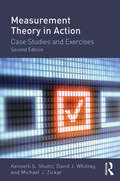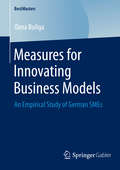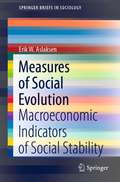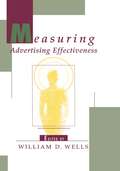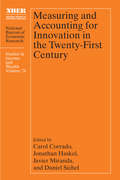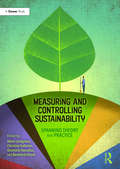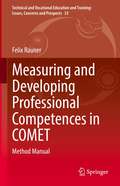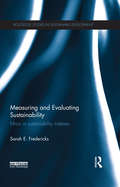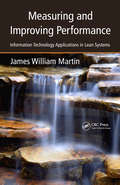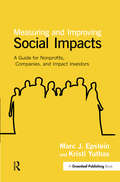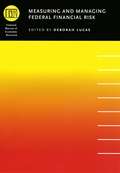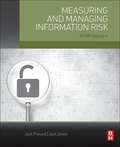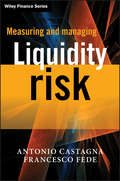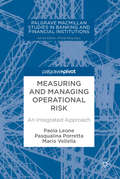- Table View
- List View
Measurement Theory in Action: Case Studies and Exercises, Second Edition
by Kenneth S. Shultz David J. Whitney Michael J. ZickarThis book helps readers apply testing and measurement theories. Featuring 22 self-standing modules, instructors can pick and choose the ones that are most appropriate for their course. Each module features an overview of a measurement issue and a step-by-step application of that theory. Best practices provide recommendations for ensuring the appropriate application of the theory. Practical questions help students assess their understanding of the topic while the examples allow them to apply the material using real data. Two cases in each module depict typical dilemmas faced when applying measurement theory followed by Questions to Ponder to encourage critical examination of the issues noted in the cases. Each module contains exercises some of which require no computer access while others involve the use of SPSS to solve the problem. The book’s website houses the accompanying data sets and more. The book also features suggested readings, a glossary of the key terms, and a continuing exercise that incorporates many of the steps in the development of a measure of typical performance. Updated throughout to reflect recent changes in the field, the new edition also features: --A new co-author, Michael Zickar, who updated the advanced topics and added the new module on generalizability theory (Module 22). -Expanded coverage of reliability (Modules 5 & 6) and exploratory and confirmatory factor analysis (Modules 18 & 19) to help readers interpret results presented in journal articles. -Expanded Web Resources, Instructors will now find: suggested answers to the book’s questions and exercises; detailed worked solutions to the exercises; and PowerPoint slides. Students and instructors can access the SPSS data sets; additional exercises; the glossary; and website references that are helpful in understanding psychometric concepts. Part 1 provides an introduction to measurement theory and specs for scaling and testing and a review of statistics. Part 2 then progresses through practical issues related to text reliability, validation, meta-analysis and bias. Part 3 reviews practical issues related to text construction such as the development of measures of maximal performance, CTT item analysis, test scoring, developing measures of typical performance, and issues related to response styles and guessing. The book concludes with advanced topics such as multiple regression, exploratory and confirmatory factor analysis, item response theory (IRT), IRT applications including computer adaptive testing and differential item functioning, and generalizability theory. Ideal as a text for any psychometrics, testing and measurement, or multivariate statistics course taught in psychology, education, marketing and management, professional researchers in need of a quick refresher on applying measurement theory will also find this an invaluable reference.
Measurement Theory in Action: Case Studies and Exercises, Second Edition
by Kenneth S. Shultz David J. Whitney Michael J. ZickarThis book helps readers apply testing and measurement theories. Featuring 22 self-standing modules, instructors can pick and choose the ones that are most appropriate for their course. Each module features an overview of a measurement issue and a step-by-step application of that theory. Best practices provide recommendations for ensuring the appropriate application of the theory. Practical questions help students assess their understanding of the topic while the examples allow them to apply the material using real data. Two cases in each module depict typical dilemmas faced when applying measurement theory followed by Questions to Ponder to encourage critical examination of the issues noted in the cases. Each module contains exercises some of which require no computer access while others involve the use of SPSS to solve the problem. The book’s website houses the accompanying data sets and more. The book also features suggested readings, a glossary of the key terms, and a continuing exercise that incorporates many of the steps in the development of a measure of typical performance. Updated throughout to reflect recent changes in the field, the new edition also features: --A new co-author, Michael Zickar, who updated the advanced topics and added the new module on generalizability theory (Module 22). -Expanded coverage of reliability (Modules 5 & 6) and exploratory and confirmatory factor analysis (Modules 18 & 19) to help readers interpret results presented in journal articles. -Expanded Web Resources, Instructors will now find: suggested answers to the book’s questions and exercises; detailed worked solutions to the exercises; and PowerPoint slides. Students and instructors can access the SPSS data sets; additional exercises; the glossary; and website references that are helpful in understanding psychometric concepts. Part 1 provides an introduction to measurement theory and specs for scaling and testing and a review of statistics. Part 2 then progresses through practical issues related to text reliability, validation, meta-analysis and bias. Part 3 reviews practical issues related to text construction such as the development of measures of maximal performance, CTT item analysis, test scoring, developing measures of typical performance, and issues related to response styles and guessing. The book concludes with advanced topics such as multiple regression, exploratory and confirmatory factor analysis, item response theory (IRT), IRT applications including computer adaptive testing and differential item functioning, and generalizability theory. Ideal as a text for any psychometrics, testing and measurement, or multivariate statistics course taught in psychology, education, marketing and management, professional researchers in need of a quick refresher on applying measurement theory will also find this an invaluable reference.
Measures for Innovating Business Models: An Empirical Study of German SMEs (BestMasters)
by Oana BuligaThe literature on business model innovation mainly regards large enterprises and is not tailored to SME characteristics. Oana Buliga takes an exploratory look at whether SMEs use strategies which are mainly designed for large enterprises for innovating their business models. The results show that SMEs generally follow successful innovations of large enterprises. Another main finding is that SMEs innovate intuitively: from common sense changes to bold innovations, which severely reshape the value creation systems on the whole. Yet, business model innovation is still a rather ambiguous term and depends on what is considered to be the industry-standard.
Measures of Social Evolution: Macroeconomic Indicators of Social Stability (SpringerBriefs in Sociology)
by Erik W. AslaksenThis book extends a previously published model of social evolution by using macroeconomic measures to indicate both the current state of the society, and its evolutionary trajectory. This model considers society as a system of interacting elements evolving through stages of increasing strength of interaction and complexity of structure. It measures society in constituting the world collectively, with nation-states as the elements, here described through macroeconomic measures such as GDP, government expenditure, and inequality. The economic data presented indicates that this stage is approaching the next evolutionary step, which is either the formation of a world society of nations, with an associated overarching common infrastructure absorbing some of the sovereign functions of nation-states as they exist today, or as a society of competing groups of nations, each bound by alliances and bilateral agreements. The book explores how the former faces great obstacles in the form of nationalism and a misunderstood concept of sovereignty, and poses that it is in an embryonic stage. The author poses that it is this structure that would be best equipped to handle common challenges, such as the environment and global warming, and topically, pandemics. A novel interdisciplinary text in social complexity, this book is of interest to researchers in socio-economic fields.
Measures of Sustainable Construction Projects Performance
by Ayodeji E. OkeThe construction industry contributes to growth and economic development in countries around the world, but it can also be wasteful and environmentally damaging. Traditionally, the success of construction projects is measured in term of time, cost, and quality; however, due to changing clients’ demands and expectations and complexity of projects, project goals are no longer limited to the conventional three indicators. The introduction of sustainability principle in every sector of the economy, especially through the United Nations Sustainable Development Goals (UNSDGs), has also affected the measures of project success. There is the need for construction projects to adopt sustainable principles such as reduce, reuse, and recycle with a view to ensuring that projects are economical, people oriented, environmentally friendly and technically appropriate. Oke builds on years of knowledge and research providing a comprehensive discussion on various metrics and variables for measuring the success and performance of sustainable construction projects; culminating in an essential text for various stakeholders concerned with the management and administration of construction and infrastructure projects in the Architecture, Engineering, Construction and Operation (AECO) industry.
Measures of Sustainable Construction Projects Performance
by Ayodeji E. OkeThe construction industry contributes to growth and economic development in countries around the world, but it can also be wasteful and environmentally damaging. Traditionally, the success of construction projects is measured in term of time, cost, and quality; however, due to changing clients’ demands and expectations and complexity of projects, project goals are no longer limited to the conventional three indicators. The introduction of sustainability principle in every sector of the economy, especially through the United Nations Sustainable Development Goals (UNSDGs), has also affected the measures of project success. There is the need for construction projects to adopt sustainable principles such as reduce, reuse, and recycle with a view to ensuring that projects are economical, people oriented, environmentally friendly and technically appropriate. Oke builds on years of knowledge and research providing a comprehensive discussion on various metrics and variables for measuring the success and performance of sustainable construction projects; culminating in an essential text for various stakeholders concerned with the management and administration of construction and infrastructure projects in the Architecture, Engineering, Construction and Operation (AECO) industry.
Measuring Advertising Effectiveness
by William D. WellsThis volume includes edited and revised versions of the papers delivered and discussed at the recent Advertising and Consumer Psychology Conference. Following the theme of the conference -- "Measuring Advertising Effectiveness" -- the book blends academic psychology, marketing theory, survey methodology, and practical experience, while simultaneously addressing the problems and limitations of advertising. Acknowledging that advertisements are subtle, diverse, complex phenomena that require detailed investigation, this compilation explores the multidimensional nature of advertising's diverse effects from both academic and applied perspectives. Updates on theories and methods -- along with expert commentaries -- help to make this a valuable collection that will be of interest to advertising and marketing specialists and communications experts alike.
Measuring Advertising Effectiveness
by William D. WellsThis volume includes edited and revised versions of the papers delivered and discussed at the recent Advertising and Consumer Psychology Conference. Following the theme of the conference -- "Measuring Advertising Effectiveness" -- the book blends academic psychology, marketing theory, survey methodology, and practical experience, while simultaneously addressing the problems and limitations of advertising. Acknowledging that advertisements are subtle, diverse, complex phenomena that require detailed investigation, this compilation explores the multidimensional nature of advertising's diverse effects from both academic and applied perspectives. Updates on theories and methods -- along with expert commentaries -- help to make this a valuable collection that will be of interest to advertising and marketing specialists and communications experts alike.
Measuring and Accounting for Innovation in the Twenty-First Century (National Bureau of Economic Research Studies in Income and Wealth)
by Carol Corrado, Jonathan Haskel, Javier Miranda and Daniel SichelMeasuring innovation is a challenging task, both for researchers and for national statisticians, and it is increasingly important in light of the ongoing digital revolution. National accounts and many other economic statistics were designed before the emergence of the digital economy and the growth in importance of intangible capital. They do not yet fully capture the wide range of innovative activity that is observed in modern economies. This volume examines how to measure innovation, track its effects on economic activity and on prices, and understand how it has changed the structure of production processes, labor markets, and organizational form and operation in business. The contributors explore new approaches to and data sources for measurement, such as collecting data for a particular innovation as opposed to a firm and using trademarks for tracking innovation. They also consider the connections between university-based R&D and business start-ups and the potential impacts of innovation on income distribution. The research suggests strategies for expanding current measurement frameworks to better capture innovative activity, including developing more detailed tracking of global value chains to identify innovation across time and space and expanding the measurement of innovation’s impacts on GDP in fields such as consumer content delivery and cloud computing.
Measuring and Accounting for Innovation in the Twenty-First Century (National Bureau of Economic Research Studies in Income and Wealth)
Measuring innovation is a challenging task, both for researchers and for national statisticians, and it is increasingly important in light of the ongoing digital revolution. National accounts and many other economic statistics were designed before the emergence of the digital economy and the growth in importance of intangible capital. They do not yet fully capture the wide range of innovative activity that is observed in modern economies. This volume examines how to measure innovation, track its effects on economic activity and on prices, and understand how it has changed the structure of production processes, labor markets, and organizational form and operation in business. The contributors explore new approaches to and data sources for measurement, such as collecting data for a particular innovation as opposed to a firm and using trademarks for tracking innovation. They also consider the connections between university-based R&D and business start-ups and the potential impacts of innovation on income distribution. The research suggests strategies for expanding current measurement frameworks to better capture innovative activity, including developing more detailed tracking of global value chains to identify innovation across time and space and expanding the measurement of innovation’s impacts on GDP in fields such as consumer content delivery and cloud computing.
Measuring and Controlling Sustainability: Spanning Theory and Practice
by Adam Lindgreen Christine Vallaster Dr Shumaila Yousofzai Bernhard HirschEfforts to establish the measurement and control of sustainability have produced notable tools, but those instruments lack applicability in practice. Increasing the level of standardization of such tools also seems difficult to achieve, because the contexts surrounding the focal organizations differ considerably. Therefore, what we need is a systematic, interdisciplinary assessment of how to measure and control sustainability, so that we can establish an essential definition and up-to-date picture of the field. Measuring and Controlling Sustainability attempts to provide such an assessment in 17 chapters, organized into four main topic sections: (a) organizations and social value creation: concepts, responsibilities, and barriers; (b) accounting, measurement, performance, and diffusion of social value; (c) practical and managerial insights from real-life cases; and (d) choices, incentives, guidance, and ethics. This research anthology provides a comprehensive collection of cutting-edge theories and research that will further the development and advancement of measuring and controlling sustainable efforts in theory and managerial practice.
Measuring and Controlling Sustainability: Spanning Theory and Practice
by Adam Lindgreen Christine Vallaster Dr Shumaila Yousofzai Bernhard HirschEfforts to establish the measurement and control of sustainability have produced notable tools, but those instruments lack applicability in practice. Increasing the level of standardization of such tools also seems difficult to achieve, because the contexts surrounding the focal organizations differ considerably. Therefore, what we need is a systematic, interdisciplinary assessment of how to measure and control sustainability, so that we can establish an essential definition and up-to-date picture of the field. Measuring and Controlling Sustainability attempts to provide such an assessment in 17 chapters, organized into four main topic sections: (a) organizations and social value creation: concepts, responsibilities, and barriers; (b) accounting, measurement, performance, and diffusion of social value; (c) practical and managerial insights from real-life cases; and (d) choices, incentives, guidance, and ethics. This research anthology provides a comprehensive collection of cutting-edge theories and research that will further the development and advancement of measuring and controlling sustainable efforts in theory and managerial practice.
Measuring and Developing Professional Competences in COMET: Method Manual (Technical and Vocational Education and Training: Issues, Concerns and Prospects #33)
by Felix RaunerThis book is a detailed manual for the implementation of competence diagnostics in the field of vocational training. With the COMET competence model, both conceptual competences as well as practical skills are recorded and evaluated. The manual guides through all methodological steps, including the preparation and implementation of tests, cross and longitudinal studies, the development of context analyses and measurement methods for the test motivation. The focus of the final chapter is the application of the COMET procedure for the design, organisation and evaluation of vocational education and training processes.
Measuring and Evaluating Sustainability: Ethics in Sustainability Indexes (Routledge Studies in Sustainable Development)
by Sarah E. FredericksThe indexes used by local, national, and international governments to monitor progress toward sustainability do not adequately align with their ethical priorities and have a limited ability to monitor and promote sustainability. This book gives a theoretical and practical demonstration of how ethics and technical considerations can aid the development of sustainability indexes to overcome this division in the literature and aid sustainability initiatives. Measuring and Evaluating Sustainability develops and illustrates methods of linking technical and normative concerns during the development of sustainability indexes. Specifically, guidelines for index development are combined with a pragmatic theory of ethics that enables ethical collaboration among people of diverse ethical systems. Using the resulting method of index development, the book takes a unique applied turn as it ethically evaluates multiple sustainability indexes developed and used by the European Commission, researchers, and local communities and suggests ways to improve the indexes. The book emphasizes justice as it is the most prevalent ethical principle in the sustainability literature and most neglected in index development. In addition to the ethical principles common to international sustainability initiatives, the book also employs a variety of religious and philosophical traditions to ensure that the ethical evaluations performed in the text align with the ideals of the communities using the indexes and foster cross-cultural ethical dialogue. This volume is an invaluable resource for students, researchers and professionals working on sustainability indicators and sustainability policy-making as well as interdisciplinary areas including environmental ethics; environmental philosophy; environmental or social justice; ecological economics; businesses sustainability programs; international development and environmental policy-making.
Measuring and Evaluating Sustainability: Ethics in Sustainability Indexes (Routledge Studies in Sustainable Development)
by Sarah E. FredericksThe indexes used by local, national, and international governments to monitor progress toward sustainability do not adequately align with their ethical priorities and have a limited ability to monitor and promote sustainability. This book gives a theoretical and practical demonstration of how ethics and technical considerations can aid the development of sustainability indexes to overcome this division in the literature and aid sustainability initiatives. Measuring and Evaluating Sustainability develops and illustrates methods of linking technical and normative concerns during the development of sustainability indexes. Specifically, guidelines for index development are combined with a pragmatic theory of ethics that enables ethical collaboration among people of diverse ethical systems. Using the resulting method of index development, the book takes a unique applied turn as it ethically evaluates multiple sustainability indexes developed and used by the European Commission, researchers, and local communities and suggests ways to improve the indexes. The book emphasizes justice as it is the most prevalent ethical principle in the sustainability literature and most neglected in index development. In addition to the ethical principles common to international sustainability initiatives, the book also employs a variety of religious and philosophical traditions to ensure that the ethical evaluations performed in the text align with the ideals of the communities using the indexes and foster cross-cultural ethical dialogue. This volume is an invaluable resource for students, researchers and professionals working on sustainability indicators and sustainability policy-making as well as interdisciplinary areas including environmental ethics; environmental philosophy; environmental or social justice; ecological economics; businesses sustainability programs; international development and environmental policy-making.
Measuring and Improving Performance: Information Technology Applications in Lean Systems
by James William MartinAs a pioneer in Lean improvement methods, Jim Martin was among the first to suggest that truly successful Lean initiatives are those applied across every facet of an organization, not just on the shop floor. Building on this concept, Martin demonstrates that one of the most effective ways to implement operational improvements across an organization
Measuring and Improving Social Impacts: A Guide for Nonprofits, Companies and Impact Investors
by Marc J. Epstein Kristi YuthasIdentifying, measuring and improving social impact is a significant challenge for corporate and private foundations, charities, NGOs and corporations. How best to balance possible social and environmental benefits (and costs) against one another? How does one bring clarity to multiple possibilities and opportunities? Based on years of work and new field studies from around the globe, the authors have written a book for managers that is grounded in the best academic and managerial research.It is a practical guide that describes the steps needed for identifying, measuring and improving social impact. This approach is useful in maximizing the impact of different types of investments, including grants and donations, impact investments, and commercial investments.With numerous examples of actual organizational approaches, research into more than fifty organizations, and extensive practical guidance and best practices, Measuring and Improving Social Impacts fills a critical gap.
Measuring and Improving Social Impacts: A Guide for Nonprofits, Companies and Impact Investors
by Marc J. Epstein Kristi YuthasIdentifying, measuring and improving social impact is a significant challenge for corporate and private foundations, charities, NGOs and corporations. How best to balance possible social and environmental benefits (and costs) against one another? How does one bring clarity to multiple possibilities and opportunities? Based on years of work and new field studies from around the globe, the authors have written a book for managers that is grounded in the best academic and managerial research.It is a practical guide that describes the steps needed for identifying, measuring and improving social impact. This approach is useful in maximizing the impact of different types of investments, including grants and donations, impact investments, and commercial investments.With numerous examples of actual organizational approaches, research into more than fifty organizations, and extensive practical guidance and best practices, Measuring and Improving Social Impacts fills a critical gap.
Measuring and Managing Federal Financial Risk (National Bureau of Economic Research Conference Report)
by Deborah LucasThe U.S. government is the world’s largest financial institution, providing credit and assuming risk through diverse activities. But the potential cost and risk of these actions and obligations remain poorly understood and only partially measured. Government budgetary and financial accounting rules, which largely determine the information available to federal decision makers, have only just begun to address these issues. However, recently there has been a push to rethink how these programs are valued and accounted for, and some progress has been made in applying modern valuation methods—such as options pricing, risk-adjusted discount rates, and value at risk—to these types of obligations. This book contains new research, both empirical and methodological, on the measurement and management of these costs and risks. The analyses encompass a broad spectrum of federal programs, including housing, catastrophe insurance, student loans, social security, and environmental liabilities. Collectively, the contributions gathered in Measuring and Managing Federal Financial Risk demonstrate that the logic of financial economics can be a useful tool for studying a range of federal activities.
Measuring and Managing Federal Financial Risk (National Bureau of Economic Research Conference Report)
by Deborah LucasThe U.S. government is the world’s largest financial institution, providing credit and assuming risk through diverse activities. But the potential cost and risk of these actions and obligations remain poorly understood and only partially measured. Government budgetary and financial accounting rules, which largely determine the information available to federal decision makers, have only just begun to address these issues. However, recently there has been a push to rethink how these programs are valued and accounted for, and some progress has been made in applying modern valuation methods—such as options pricing, risk-adjusted discount rates, and value at risk—to these types of obligations. This book contains new research, both empirical and methodological, on the measurement and management of these costs and risks. The analyses encompass a broad spectrum of federal programs, including housing, catastrophe insurance, student loans, social security, and environmental liabilities. Collectively, the contributions gathered in Measuring and Managing Federal Financial Risk demonstrate that the logic of financial economics can be a useful tool for studying a range of federal activities.
Measuring and Managing Information Risk: A FAIR Approach
by Jack Jones Jack FreundUsing the factor analysis of information risk (FAIR) methodology developed over ten years and adopted by corporations worldwide, Measuring and Managing Information Risk provides a proven and credible framework for understanding, measuring, and analyzing information risk of any size or complexity. Intended for organizations that need to either build a risk management program from the ground up or strengthen an existing one, this book provides a unique and fresh perspective on how to do a basic quantitative risk analysis. Covering such key areas as risk theory, risk calculation, scenario modeling, and communicating risk within the organization, Measuring and Managing Information Risk helps managers make better business decisions by understanding their organizational risk.Uses factor analysis of information risk (FAIR) as a methodology for measuring and managing risk in any organization.Carefully balances theory with practical applicability and relevant stories of successful implementation.Includes examples from a wide variety of businesses and situations presented in an accessible writing style.
Measuring and Managing Liquidity Risk (The Wiley Finance Series)
by Antonio Castagna Francesco FedeA fully up-to-date, cutting-edge guide to the measurement and management of liquidity risk Written for front and middle office risk management and quantitative practitioners, this book provides the ground-level knowledge, tools, and techniques for effective liquidity risk management. Highly practical, though thoroughly grounded in theory, the book begins with the basics of liquidity risks and, using examples pulled from the recent financial crisis, how they manifest themselves in financial institutions. The book then goes on to look at tools which can be used to measure liquidity risk, discussing risk monitoring and the different models used, notably financial variables models, credit variables models, and behavioural variables models, and then at managing these risks. As well as looking at the tools necessary for effective measurement and management, the book also looks at and discusses current regulation and the implication of new Basel regulations on management procedures and tools.
Measuring and Managing Liquidity Risk (The Wiley Finance Series)
by Antonio Castagna Francesco FedeA fully up-to-date, cutting-edge guide to the measurement and management of liquidity risk Written for front and middle office risk management and quantitative practitioners, this book provides the ground-level knowledge, tools, and techniques for effective liquidity risk management. Highly practical, though thoroughly grounded in theory, the book begins with the basics of liquidity risks and, using examples pulled from the recent financial crisis, how they manifest themselves in financial institutions. The book then goes on to look at tools which can be used to measure liquidity risk, discussing risk monitoring and the different models used, notably financial variables models, credit variables models, and behavioural variables models, and then at managing these risks. As well as looking at the tools necessary for effective measurement and management, the book also looks at and discusses current regulation and the implication of new Basel regulations on management procedures and tools.
Measuring and Managing Operational Risk
by Paola Leone Pasqualina Porretta Mario VellellaThis book covers Operational Risk Management (ORM), in the current context, and its new role in the risk management field. The concept of operational risk is subject to a wide discussion also in the field of ORM's literature, which has increased throughout the years. By analyzing different methodologies that try to integrate qualitative and quantitative data or different measurement approaches, the authors explore the methodological framework, the assumptions, statistical tool, and the main results of an operational risk model projected by intermediaries. A guide for academics and students, the book also discusses the avenue of mitigation acts, suggested by the main results of the methodologies applied. The book will appeal to students, academics, and financial supervisory and regulatory authorities.
Measuring and Managing Operational Risk: An Integrated Approach
by Paola Leone Pasqualina Porretta Mario VellellaThis book covers Operational Risk Management (ORM), in the current context, and its new role in the risk management field. The concept of operational risk is subject to a wide discussion also in the field of ORM’s literature, which has increased throughout the years. By analyzing different methodologies that try to integrate qualitative and quantitative data or different measurement approaches, the authors explore the methodological framework, the assumptions, statistical tool, and the main results of an operational risk model projected by intermediaries. A guide for academics and students, the book also discusses the avenue of mitigation acts, suggested by the main results of the methodologies applied. The book will appeal to students, academics, and financial supervisory and regulatory authorities.
